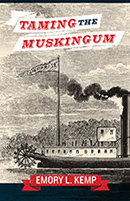Summary
Few reference works are as valuable to scholars and non-scholars as an historical atlas. The Historical Atlas of West Virginia is important title for libraries, schools, and every West Virginian who wants to understand how historical forces are mapped onto the state’s terrain. Frank Riddel’s The Historical Atlas of West Virginia is copiously illustrated with maps, tables, and charts depicting everything from geological deposits and strata that have fed the state’s industries to the settlement patterns of the immigrants who settled in West Virginia. Using federal and state statistics, it also includes revelations from the national census figures since 1790.
2008 ForeWord Magazine Book of the Year Award Finalist
2008 Southeastern Library Association Southern Book Competition, Honorable Mention for Typographical Design
Contents
- Preface
- About the Author
- GEOGRAPHY
- West Virginia’s Location
- Latitude, Longitude, and Size of West Virginia
- West Virginia within the Appalachian Region
- West Virginia’s Borders
- Physical Subdivisions of West Virginia
- Land Relief in West Virginia
- Major Rivers in West Virginia
- Natural Wonders in West Virginia
- State and National Parks and Forests in West Virginia
- HISTORY
- The Adena and Hopewell Heartland
- Early Woodland Sites in West Virginia, 1000 B.C.–A.D. 1
- Early Middle Woodland Sites in West Virginia, A.D. 1–A.D. 500
- Late Middle Woodland Sites in West Virginia, A.D. 500–A.D. 1000
- Late Prehistoric Cultures in West Virginia, 1000–1700
- Major Indian Tribes and Their Approximate Locations during the Late Prehistoric and Early Historic Periods
- Major Indian Trails in West Virginia
- Hunting Areas of Predominant Tribes in West Virginia Early in the 18th Century
- Territorial Provisions of the Virginia Charter of 1606
- Territorial Provisions of the Virginia Charter of 1609
- The Exploration of Western Virginia, 1650–1673
- The Exploration of Western Virginia, 1674–1749
- The Exploration of Western Virginia, 1750–1752
- The Fairfax Proprietary: Granted in 1649 and Defined by Surveys in 1736 and 1746
- The Great Land Companies of Colonial Virginia
- European Claims East of the Mississippi, 1713–1763
- Frontier Defenses in Western Virginia, 1750–1792
- Virginia and Conflict between France and Great Britain, 1753–1763
- European Possessions after the French and Indian War, 1763–1776
- Settlement in West Virginia by 1763
- Pontiac’s Rebellion, 1763–1764
- The Royal Proclamation of 1763: A Barrier to Settlement beyond the Mountains
- The Indian Boundary Line, 1768–1771
- Land Schemes in Western Virginia: Indiana and Vandalia
- Dunmore’s War—1774
- An Effort to Create a New State in Western Virginia: Westsylvania
- The American Revolution in Western Virginia
- The New Nation—1783
- The Virginia-Pennsylvania Boundary Dispute
- Western Land Claims and Cessions, 1776–1802
- The Reduction of Virginia’s Land Claims, 1632–1863
- Reducing the Indian Threat to Western Virginia, 1793–1795
- Settlement in West Virginia by 1800
- The Civil War in West Virginia—1861
- The Civil War in West Virginia—1862
- The Civil War in West Virginia—1863
- The Civil War in West Virginia—1864
- The Civil War in West Virginia—1865
- Counties Represented at the First Wheeling Convention—May 1861
- Results of the Virginia Referendum on Secession in the Counties that became the State of West Virginia—May 23, 1861
- Counties Represented at the Second Wheeling Convention—June 1861
- Boundaries of the Proposed State of ‘Kanawha’
- Results of the Referendum on the New State Ordinance—October 24, 1861
- Boundaries of West Virginia Adopted by the Constitutional Convention (November 26, 1861–February 18, 1862)
- Boundaries of West Virginia when Admitted to the Union—June 20, 1863
- West Virginia’s Capitals
- The West Virginia Mine Wars, 1912–1913 and 1919–1921
- Absentee Ownership in West Virginia
- THE EVOLUTION OF COUNTIES
- Western Virginia Counties, 1734–1742
- Western Virginia Counties, 1743–1753
- Western Virginia Counties, 1754–1771
- Western Virginia Counties, 1772–1775
- Western Virginia Counties, 1776–1778
- Western Virginia Counties, 1779–1782
- Western Virginia Counties, 1783–1791
- Western Virginia Counties, 1792–1800
- Western Virginia Counties, 1801–1810
- Western Virginia Counties, 1811–1820
- Western Virginia Counties, 1821–1830
- Western Virginia Counties, 1831–1840
- Western Virginia Counties, 1841–1850
- Western Virginia Counties, 1851–1863
- West Virginia Counties, 1863–Present
- West Virginia County Seats
- THE DEVELOPMENT OF TRANSPORTATION
- Principal Roads in Western Virginia in 1800
- Principal Roads in Western Virginia in 1835
- Principal Roads in Western Virginia during the Civil War
- Principal Roads in West Virginia in 1955
- Principal Roads in West Virginia in 2008
- Railroads in West Virginia in 1863
- Railroads in West Virginia in 1893
- Railroads in West Virginia in 1920
- Railroads in West Virginia in 2000
- Locks and Dams in West Virginia
- Public Airports in West Virginia
- NATURAL RESOURCES AND EXTRACTIVE INDUSTRIES
- Salt Deposits in West Virginia
- Major Lumber-Producing Counties in West Virginia
- Oil Deposits in West Virginia
- Natural Gas Deposits in West Virginia
- Coal Deposits in West Virginia
- EDUCATION
- Academies Established in Western Virginia prior to the Civil War
- Institutions of Higher Education in West Virginia
- POPULATION, 1790–2000
- Western Virginia’s Population in 1790
- Western Virginia’s Population in 1800
- Western Virginia’s Population in 1810
- Western Virginia’s Population in 1820
- Western Virginia’s Population in 1830
- Western Virginia’s Population in 1840
- Western Virginia’s Population in 1850
- Western Virginia’s Population in 1860
- West Virginia’s Population in 1870
- West Virginia’s Population in 1880
- West Virginia’s Population in 1890
- West Virginia’s Population in 1900
- West Virginia’s Population in 1910
- West Virginia’s Population in 1920
- West Virginia’s Population in 1930
- West Virginia’s Population in 1940
- West Virginia’s Population in 1950
- West Virginia’s Population in 1960
- West Virginia’s Population in 1970
- West Virginia’s Population in 1980
- West Virginia’s Population in 1990
- West Virginia’s Population in 2000
- LEGISLATIVE, JUDICIAL, AND CONGRESSIONAL DISTRICTS
- West Virginia House of Delegates Districts
- West Virginia State Senate Districts
- West Virginia Judicial Circuits
- West Virginia Congressional Districts (Apportionment of 1863)
- West Virginia Congressional Districts (Apportionment of 1882)
- West Virginia Congressional Districts (Apportionment of 1901)
- West Virginia Congressional Districts (Apportionment of 1915)
- West Virginia Congressional Districts (Apportionment of 1934)
- West Virginia Congressional Districts (Apportionment of 1951)
- West Virginia Congressional Districts (Apportionment of 1961)
- West Virginia Congressional Districts (Apportionment of 1971)
- West Virginia Congressional Districts (Apportionment of 1982)
- West Virginia Congressional Districts (Apportionment of 1992)
- West Virginia Congressional Districts (Apportionment of 2002)
- Appendix A: Governors of West Virginia
- Appendix B: United States Senators from West Virginia
- References
- Index
Author
Frank S. Riddel is originally from St. Mary’s, WV, and holds undergraduate and master’s degrees from Marshall University and a doctoral degree from the Ohio State University. He has co-authored two books published by the West Virginia Historical Education Foundation, West Virginia Government and American Government: The USA and West Virginia. He is currently an emeritus professor of history at Marshall University where he continues to teach West Virginia history.
Reviews
“The Historical Atlas of West Virginia is a significant contribution to the literature on the state of West Virginia. . . . In all, a handsome and useful work . . . whose maps will be used by generations to come for a better understanding of our state.”
Kenneth C. Marris, West Virginia History
“ . . . fills a major gap in West Virginia historiography.”
West Virginia Archives & History News












